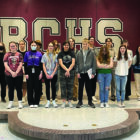Conversations
Holiday Charitable Giving
April, 2024
Why some St. Albert charities are feeling the cold this holiday season
So far in 2023, the St. Albert Food Bank is holding its own, said its Executive Director Suzan Krecsy, although she’s noticed some familiar faces among its recipients of late. “We are seeing folks that used to be our donors who are now receiving food hampers,” she said. ”Who knows if this trend will continue or not?”
Meanwhile, Rosanna Fischer, President of KDM Helping Hands, which assists local, needy children and families, recalled that its 2022 campaign experienced a massive shortfall compared to the previous year’s coffers, which she attributed to inflation, an unpredictable economy and more charities competing for donations. “Contrary to what many think, St. Albert is not immune to these challenges,” she added.
Feeling the donor pinch
Digging themselves out of the social paralysis brought about by COVID-19 and corresponding lockdowns only to be gripped by rampant inflation spawned in part by the pandemic, people don’t seem to be as generous as they used to be. From St. Albert’s standpoint, it’s certainly not for lack of benevolent will as local residents have provided assistance of late to accommodate temporary evacuees from wildfires raging in northern Alberta and the Northwest Territories and refugees fleeing war-torn Ukraine. But a metropolis with enough prosperity to enjoy top-20 status in Resonance Consulting’s 2022 assessment of Canada’s best small cities and still feel the donor pinch is particularly telling.
If anything, the dwindling spirit of giving that otherwise underscores the vibe of the holiday season indicates that St. Albert is in good company. In the U.S., the Wall Street Journal reported that donations in 2022 dropped by almost 24 percent compared to the previous year. Domestically, an Environics Canada and CanadaHelps report used tax filings to reveal that 18.4 percent of Canadians donated to charity, a steady downturn of five percent over the past decade, while respondents stating a need for charitable assistance jumped to 22 percent.
Roughly 3,000 charities surveyed in the report revealed that more than 40 percent of them have experienced a lasting increase in demand since the pandemic. Alarmingly, 57 percent of them said they weren’t able to meet that demand, while 32 percent of them raised fewer funds in 2022. Besides shortfalls, more than half of the charities polled in the report also reflected concern over staff burnout and a reduction in volunteer help.
The report’s survey of close to 3,000 charities revealed that since the pandemic, over 40 percent of charities have experienced a lasting increase in demand. However, over 57 percent cannot meet current levels of demand and almost 32 percent raised fewer funds in 2022. Over half of charitable organizations are also deeply concerned about staff burnout, and have fewer volunteers than before the pandemic.

Soldiering on
Facing these obstacles, local charities are still soldiering on. The St. Albert Salvation Army’s annual, six-week long Christmas Kettle campaign raised $350,000 to provide toys to some 200 families, said Bhreagh Rowe, its Community Ministries Officer. But recently, the not-for-profit establishment has had to reach its fundraising goals the hard way.
“We have lost a few big corporate donors which has had an effect on our bottom line, but not a massive effect in our kettle campaign. We are not seeing an increase in donations overall but [are] currently maintaining well.”
Bhreagh Rowe, St.Albert Salvation Army
The kettle drive is responsible for 90 percent of the organization’s budget, which covers the costs of projects that include youth programs, a market and café, and free yoga classes. All the money raised stays in the Sturgeon and Parkland counties, added Rowe, who estimated that roughly 50 local residents seek the Salvation Army’s help each week.
Meanwhile, The Giving Tree, supported by employees in the City of St. Albert’s Recreation and Parks department, had to adjust its expectations after the pandemic shut the initiative down in 2020 and 2021. In 2022, the charity donated 242 winter-wear items to residents at the St. Albert Community Village, adding to the cumulative 2,500 articles of seasonal apparel it’s donated since starting in 2016.
The Giving Tree doesn’t operate with quotas in mind each year. ”Rather, we approach the Giving Tree project as ‘every little bit counts,’ especially during the holiday season,” said Molly Bujold, a communications advisor with the City of St. Albert. “After facility closures and difficult years due to the pandemic, we’re thrilled with the number of donations we were able to provide and look forward to adding to this number in 2023.”
Bujold added that staffers often throw a little extra into the mix by knitting and crocheting items for the cause during the year. And while The Giving Tree doesn’t accept cash, donations have remained consistent each year.

Recovering from shortfalls
Conversely, KDM Helping Hands is recovering from the previous campaign’s $20,000 drop in support, which goes to subsidize its KDM Christmas for Kids program, which supplies free lunches, gifts, and a visit from Santa for students at a designated school. Also affected was its “Time for You” Salon self-care initiative for families at Ronald McDonald House and the establishment of a Serenity Room at Sturgeon Family Hospital. Other activities include providing holiday hampers, meal trains, and gift cards to children and families in need.
This year, the organization decided to reach regular donors earlier via social media postings and email campaigns.
“The challenge each year is expanding the existing base, something we are working on this year through other fundraising initiatives. IIn addition, we always take a “thank-you” ad after our flagship event to recognize and thank all our donors.”
Rosanna Fischer, President of KDM Helping Hands
It’s KDM’s way of acknowledging the difference all that help makes, especially during a time when donation and volunteer fatigue are undermining charitable efforts. “By extending a helping hand, you’re not just offering practical assistance, but also spreading hope and compassion,” Fischer noted, “fostering a sense of belonging and support for those who need it most.”
That seems to be a similar sentiment regarding the St. Albert Food Bank, which managed to meet all of its requests for assistance in 2022. But with 1,400 families in its database, Krecsy anticipates this holiday season will see roughly 850 food hampers be delivered to recipients, nearly 60 percent more than what they provided the previous year.
Krecsy said she was cautiously optimistic that the organization can meet that demand, but couldn’t determine precisely what will be needed beyond that. “It’s very hard to accurately predict what next year will bring,” she said. “I would say that the community of St. Albert is incredibly generous and responsive and collaborative and this is what is helping to keep things going for us.”
“I would say that the community of St. Albert is incredibly generous and responsive and collaborative and this is what is helping to keep things going for us.”













